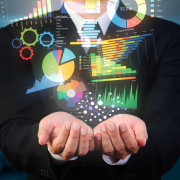Why Information Visualization Is Key For Cyber Security
When you work with cyber security, it can seem like there’s barely any difference between comprehension and chaos when it comes to looking through your data. In the often turbulent landscape of cyber threats, vast data sets, and complex network structures, even the most seasoned IT professional can get overwhelmed.
So what’s the best way to combat this problem? It’s a deceptively simple answer: visualization. Through the clever use of visual techniques, we can bring order to the digital domain, turning inscrutable streams of data into clear and actionable insights.
The Power of Perception in Cyber Defense
The need for visualization in cyber security is greater than ever. With cyberattacks growing in scope and scale, the ability to quickly understand, analyze, and respond to threats is a necessity, not a luxury.
Imagine a scenario where a security team is tasked with reviewing logs to identify a potential breach. The traditional approach of sifting through raw data is cumbersome and time consuming, and it holds the team back, delaying detection and response as minutes tick away.
Now, picture the same data presented through network visualizations or interactive graphs, where patterns and anomalies stand out at a glance. In this scenario, the power of perception is wielded in favor of the defenders, giving them a critical edge in their battle against cyber adversaries.
Making Sense of the Data Deluge
Every second, vast amounts of data flow through network infrastructures. Within this data tsunami lies the information that can signal an impending threat or uncover the aftermath of a breach. However, this valuable insight is often buried under layers of unstructured or incomprehensible data.
Information visualization can peel back these layers, making the story within the data clear and visible even to casual observers.. What used to be rows of numbers and text logs are now easily digestible, dynamic graphs that illustrate traffic patterns, heat maps that highlight user behavior, and pie charts that break down attack vectors. By presenting information in an accessible and visual format, organizations can cut through the data clutter and focus on the critical information that matters the most in the face of cyber threats.
Mastering the Art of Visualizing Cyber Data
Visualizations come in various forms, each offering a unique lens through which to view cyber data. There are many, many different ways to show your data in a visual manner, but here are several fundamental types of visualization and their applications in the context of cyber security.
Types of Visualization Techniques
Pie Charts: Excellent for showing proportions, pie charts can illustrate the distribution of attack types, malware families, or vulnerabilities within a system.
Network Diagrams: Perfect for displaying network topologies and traffic patterns, network diagrams are invaluable for understanding the flow of data and identifying potential weak points in a system.
Heat Maps: Ideal for portraying information density, heat maps can reveal the concentration of login attempts, data transfers, or other activities within a network.
Word Clouds: A creative way to present textual data, word clouds can emphasize the most common words used in phishing emails or the frequently occurring terms in a breach report.
Choosing the Right Visual Elements
Selecting the appropriate visual elements is a key part of conveying your message accurately and concisely to a large group of people. While you may think that the aesthetics of a data visualization isn’t necessary to convey information, color schemes, shapes, and size can highlight important data points, trends, or outliers. Taking a mindful approach to your visual elements can steer the attention of the viewer to the core issues without overloading them with unnecessary information.
Color Palette: A harmonious color palette can make complex graphs more accessible, with colors used consistently to represent data categories.
Size and Shape: Varying the size or shape of assets within a visualization can draw the eye to significant figures or trends.
Icons and Symbols: Incorporating visual shortcuts like icons or symbols can help viewers quickly interpret charts or diagrams, especially when dealing with complex data sets.
Best Practices in Data Visualization for Cyber Professionals
With data visualization becoming an invaluable tool in any cyber security team’s arsenal, it’s vital to understand the best practices to use when presenting your graphs to others. Cyber professionals should consider the following guidelines to ensure their visualizations are effective.
Telling a Compelling Story with Data
A good visualization doesn’t just represent data; it tells a story. Even amidst the raw data you uncover, there’s a narrative that’s being conveyed when you craft it into a visualization that can be presented to others–especially those who don’t have the same intimate knowledge of what cyber security entails. Whether it’s a cautionary tale of a breach’s lifecycle or a success story of averted threats, the visual should guide your audience along a clear and engaging data-driven path.
Designing for Accessibility and Understanding
Not all viewers of your visualizations will have the same expertise. It is essential to design visualizations that are accessible to multiple levels of understanding. Possible users could range from entry-level analysts to seasoned CISOs. Including explanatory text, tooltips, and a clear legend can help demystify complex visualizations for a broader audience.
Continual Iteration and Evolution
Data and threats evolve continually, so it’s only natural that visualizations should, too. Regularly reviewing and updating the methods in which data is presented can lead to more relevant insights. Additionally, seeking out new tools and techniques can keep visualizations fresh and align them with the latest industry standards.
Leveraging Data Visualization Tools in Cyber Security
The market is brimming with data visualization tools, each offering its unique set of features and advantages. When searching for a tool to help visualize your data, you may want to look into an all-in-one solution like Lumics. Not only will you be able to pull up easily understood graphs and other data visualizations, but you’ll be able to have a full scale network monitoring system that can prevent cyberthreats before they even happen rather than trying to clean up after a cyber security breach.
The Future of Information Visualization in Cyber Security
As cyber security continues to grow in complexity and importance, information visualization will evolve to become even more integral to its practice. We can expect to see advancements in AI and machine learning, further enhancing our ability to process and present data effectively.
The coming years will likely bring about new types of visualizations, catered specifically to the intricacies of cyber threats and the technologies that protect against them. One thing is sure — the future will belong to those who can not only gather data but visualize it in ways that lead to swift and decisive action.
Bring Your Data To Life With Visualization
The significance of information visualization in cyber security cannot be overstated. It is a powerful tool that transforms raw data into actionable intelligence, showing patterns and insights that might otherwise be overlooked.
By mastering the art of visualization, cyber security professionals can gain sharper, more intuitive insights into their networks, allowing them to create a formidable defense against an increasingly complex array of threats. Plus, it allows them to convey their information easily to those who may not have the same understanding of cyber security that IT professionals do.
Incorporating visualization into cyber security strategies is no longer something that’s nice to have; it’s a necessity for the safety of your information. It is the lens through which we can view the digital world, casting light on the shadows that conceal danger and allowing us to take proactive measures to ensure our online safety and security.




